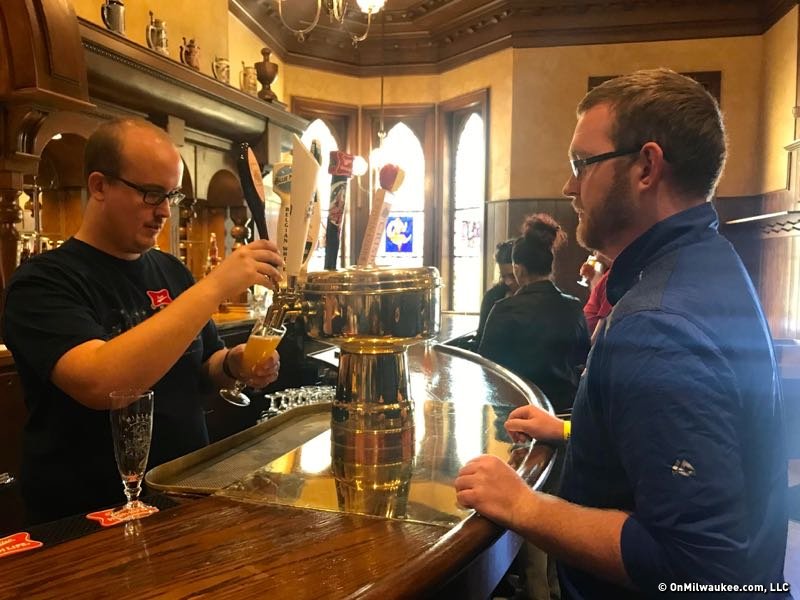{image1}"If you've got the time, we've got the beer."
The Champagne of Bottled Beers, the Girl in the Moon, the beer made the American way, the home of Miller Time and the High Life man. As old as the airplane, the World Series and Ford Motor Company, Miller High Life has weathered countless competitors, Prohibition, and the onslaught of light, dry and ice beers to reach its 100th birthday at a time when the brand is riding a wave of revival.
In many ways, Miller High Life is a microcosm of Milwaukee: unpretentious with a proud, strong tradition, embracing a no-nonsense approach but also enjoying what life has to offer. Both are usually cold, refreshing and just plain enjoyable. Of course, both are very conducive to corner bars. Consequently, both know how to celebrate.
Miller High Life officially turned 100 on December 30, 2003, making it a Capricorn. Miller Brewing Company -- now owned by South African-based SAB -- marks the century-old milestone over 2004 with a slew of events, from ad campaigns to commemorative packaging, from racing to summer tours featuring a new and improved resurrection of the famous High Life Cruiser.
Carl Cahill, the senior associate brand manager for Miller High Life, says he looks forward to the commemoration of the beer's first 100 years.
"We've been thrilled with the consumer response. Our message, emphasizing our history and adhering to traditional values, along with the re-launch of our original bottle shape, has really paid off for us, giving us good, consistent growth."
The "message" includes those commercials you've seen celebrating the High Life -- and the High Life man's way of life. The memorable ads, narrated by Doug Jeffers, illustrate High Life as brand toasting the hard worker: the resourceful, down-to-earth beer drinker who embraces traditional values and hard work that pays off. No other beer commercial, after all, has featured the line "nice wrench work, chief."
Items like as duct tape, deviled eggs and beer tap handles complimenting "hot" and "cold" taps on a kitchen sink pepper commercials whose position and cadence have contributed to the brand's recent resurgence. It's allowed High Life to carve out a unique identity, standing above the noise and hectic nature of most beer commercials.
In 1998, Miller also relaunched the original Miller High Life bottle shape, including clear glass which is not too common among beer brands.
Among other arenas, Miller High Life's promotional efforts involve racing. Bobby Allison won the Winston Cup in 1983 with Miller High Life as his sponsor, and this year a Miller High Life racer will be featured in 19 races during the 2004 NASCAR Grand National Series.
"We built our NASCAR program around the 100th anniversary and tied it in with Bobby Allison's 20th anniversary of the Winston Cup victory," Cahill notes.
Racing is only part of the High Life history; the High Life Cruiser, a 1950s-era bus designed by Brooks Stevens, used to swing through cities on promotional tours. The next generation is approaching: a refurbished bus, the new High Life Cruiser, will go on a 20-city national P.R. tour this summer. It will be a museum of Miller High Life, showcasing the history, brewing, packaging and advertising of the beer, along with what it means to live "the High Life."
Also coming in 2004 are additional advertisements -- most featuring Jeffers narrating -- along with numerous promotions that highlight not only the beer's century mark, but also its ties to the history of Miller Brewing, adherence to values, and embracing Miller High Life as one of the great inventions of the 20th century -- along with mayonnaise, TV dinners, charcoal briquettes, recliners, pizza delivery, WD-40, duct tape and sliced bread.
The unique identity behind High Life contributes to its top 10 ranking by volume among all beer brands nationally; it's ninth to be exact, making it Miller Brewing's second-largest selling beer, behind Lite. The pattern of sales growth, however, may push its ranking higher as we head into the 21st century.
"Overall," Cahill says, "we're excited about the future -- and the next 100 years."







